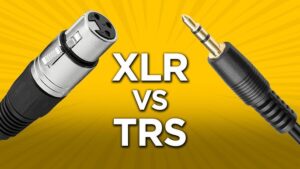When setting up studio monitors, audio interfaces, or live sound equipment, you’ll often face the choice between XLR cables and TRS cables.

XLR vs TRS Cables
Both are widely used for balanced audio connections, but they’re not identical. Knowing the differences helps you avoid noise issues and choose the right cable for your setup.
1. What is an XLR Cable?
An XLR cable is one of the most common professional audio cables.
Connector: Circular with 3 pins (though versions with more pins exist).
Gender: Male (pins) and Female (holes).
Design: Locks in place for secure connection.
Use: Microphones, mixers, powered speakers, professional audio gear.
💡 Key Advantage: Rugged and reliable, designed for long cable runs with minimal interference.
2. What is a TRS Cable?
A TRS cable looks like a standard headphone plug but with two black rings on the connector tip.
TRS = Tip-Ring-Sleeve
Shape: 1/4 inch (6.35mm) or 1/8 inch (3.5mm).
Use: Balanced line-level signals or stereo unbalanced signals.
Typical Applications: Studio monitors, audio interfaces, patch bays, headphones.
💡 Key Advantage: Compact and versatile, can carry either stereo (left/right) or balanced mono signals.
3. XLR vs TRS: Physical Differences
| Feature | XLR Cable | TRS Cable |
|---|---|---|
| Connector Shape | Circular, 3-pin | Straight plug, Tip-Ring-Sleeve |
| Locking Mechanism | Yes (secure fit) | No (push-fit) |
| Typical Size | Larger, bulkier | Smaller, lightweight |
| Durability | Very rugged | Less rugged |
| Common Lengths | 3ft – 100ft | 1ft – 25ft |
4. Balanced vs Unbalanced Signals
Both XLR and TRS can carry balanced audio, which reduces noise over long distances.
Balanced (XLR / TRS):
Uses 2 signal wires + 1 ground.
Noise picked up along the cable is canceled.
Ideal for professional audio setups.
Unbalanced (TS, RCA):
Uses 1 signal wire + 1 ground.
More prone to interference.
OK for short cable runs.
👉 XLR is always balanced.
👉 TRS can be balanced or stereo unbalanced.
5. Typical Use Cases
XLR Cable:
Microphones to mixers
Audio interface to studio monitors
Stage equipment (long runs)
TRS Cable:
Audio interface to studio monitors
Mixer inserts and patch bays
Headphones (stereo TRS, aka 'aux jack')
6. Which Should You Use: XLR or TRS?
It depends on your equipment:
Choose XLR if:
✅ Your device has XLR outputs/inputs
✅ You need secure, rugged connections
✅ You’re running long cables (20ft or more)Choose TRS if:
✅ Your device has TRS outputs/inputs
✅ You want a compact connection
✅ You’re patching short runs in a studio
👉 If both are available, XLR is usually preferred for reliability.
🔎 Conclusion
Both XLR and TRS cables deliver balanced, professional-quality audio. The main difference lies in the connector type, durability, and use case.
XLR = secure, rugged, long runs (microphones, stage use).
TRS = compact, versatile, short runs (studio monitors, patch bays).
When in doubt, check your device’s inputs/outputs. If it supports both, choose XLR for critical connections and TRS for convenience.






3 comments
Kapte69 slot 09/09/2025
I just could not go away your web site before suggesting that I really enjoyed the usual information an individual provide for your guests? Is going to be again incessantly to check up on new posts
Pg slot demo 09/09/2025
Hello there! I could have sworn I've been to this site before but after browsing through some of the post I realized it's new to me. Anyhow, I'm definitely delighted I found it and I'll be bookmarking and checking back often!
Paito hk6d 09/10/2025
Thanks very nice blog!